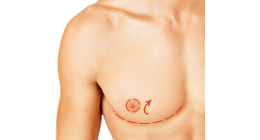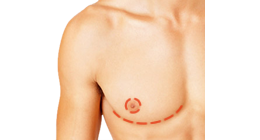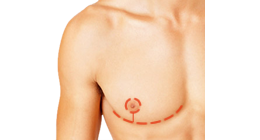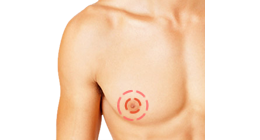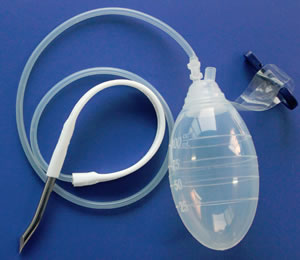FTM Top Surgery & Post-Surgical Drains
Are Drains Really Necessary?
For many trans men, post-surgical drains can be one of the most frustrating and irritating parts of recovering from Top Surgery. Are they really necessary?
What are drains? Drains remove and collect blood, pus or other excess fluids that can collect inside your chest after Top Surgery. If fluids are given a chance to build up, complications and/or infection can set in and healing can be delayed. Excess fluid in a post-surgical site can also cause pain and swelling. Drains also prevent build up of excess air (dead space.)
The Jackson-Pratt or JP drain is the more commonly used type of drain for Top Surgery. (Some surgeons use Penrose drains.) The JP drain consists of a plastic tube and bulb to collect fluids.
Ultimately, drains help you heal faster.
While the benefits of using drains after Top Surgery seem obvious, there's actually a lack of definitive evidence as to their efficacy and the question of whether or not they are necessary remains open to debate. For example, evidence for drains reducing infection and hematoma formation after breast surgery has been shown to be inconsistent. (McCarthy et al., 2007.) However, drains have been consistently shown to be effective at reducing the incidence of seroma formation (seromas are fluid collections beneath the skin) in many types of surgery.
Drains are also come with their own risks, such as infection, discomfort, and inefficient drainage due to obstruction, drain diameter, poor drain placement, or premature removal.
As of this writing, there are no studies that specifically examine the efficacy of drains with FTM Top Surgery, but we can look to Surgeons who have done a lot of Top Surgery work in their practice to learn about their clinical experience with drains in Top Surgery patients.
Dr. Scott Mosser, a board-certified Surgeon who specializes in Top Surgery, uses drains on some patients, but not on all. While he uses them for almost all of his keyhole patients, he makes the decision about whether or not to use drains on a case-by-case basis when performing the Double Incision method. With all of his Top Surgery patients, Dr. Mosser does meticulous chest contouring, going into the upper chest and sides to make the contour smooth and uniform. With this technique, he does a lot of undermining — cutting the fibrous tissue that connects the skin to the underlying fascia. When a lot of undermining is performed, drainage is typically necessary to prevent seroma and hematoma formation.
Many trans men dread the idea of post-surgery drains, but with the way that Dr. Mosser performs Double Incision, there are no extra incisions for the drainage tubes. Instead, the tubes exit the chest from the incision below the pectoral muscle. For Dr. Mosser's patients, this has resulted in less pain associated with drain incisions, as well as less scarring.
There's a small but growing number of Surgeons who do not use post-surgical drains in Top Surgery patients. If you're concerned about drains with your surgery, this approach may be worth investigating. But you can also rest assured that most post-op trans guys will tell you that drains weren't as bad as they'd anticipated! And if they're doing their job of reducing the risks of fluid build up and infections, and helping you heal from Top Surgery faster, wouldn't you say that's necessary?
Top Surgery Drains FAQ
How are drains cared for after Top Surgery?
You will need to empty your drains twice a day (or more), and record the fluid output. Your surgeon will provide you with instructions about how to do this hygienically. Check out this video by Dr. Drew Schnitt explaining how to properly care for your drains after Top Surgery.
Are drains painful?
Pain associated with post-surgical drains tends to be related to either the incision site or the removal of drains. Icing can help with pain at the incision site. Having drains removed produces more of a weird sensation than painful. Some surgeons prescribe a pain killer to take beforehand, but this isn't necessary for most patients. Drain removal takes just seconds and it will be over before you know it!
When can I get my drains removed?
Surgeons follow different guidelines on this, but drains are usually removed when the fluid output is below 20cc - 30cc for a couple of days. In Top Surgery patients, this takes about 5-7 days.
Is there anything I can do to get my drains removed sooner?
While it's been said that too much activity with your arms can lead to increased fluid, some Surgeons insist that there's no scientific evidence of this. Some trans guys drain more, some drain less. That said, many Surgeons recommend that you limit activity during healing, especially with your upper body, to reduce fluid output.
 Dr. Scott W. Mosser, MD, FACS is a board certified (American Board of Plastic Surgeons), award-winning plastic surgeon who is an expert at performing several types of FTM/N Top Surgery. Dr. Mosser is a member of WPATH and accepts insurance for Top Surgery from a growing list of insurance companies. Based in San Francisco, Dr. Mosser sees patients from around the country.
Dr. Scott W. Mosser, MD, FACS is a board certified (American Board of Plastic Surgeons), award-winning plastic surgeon who is an expert at performing several types of FTM/N Top Surgery. Dr. Mosser is a member of WPATH and accepts insurance for Top Surgery from a growing list of insurance companies. Based in San Francisco, Dr. Mosser sees patients from around the country.
References
McCarthy CM, Disa JJ, Pusic AL, Mehrara BJ, Cordeiro PG. The effect of closed-suction drains on the incidence of local wound complications following tissue expander/implant reconstruction: a cohort study. Plast Reconstr Surg. 2007 Jun;119(7):2018-22.
Surgical Drains - Indications, Management and Removal - patient.info
Last updated: 08/26/21
